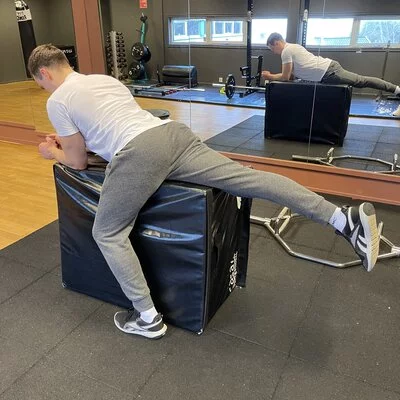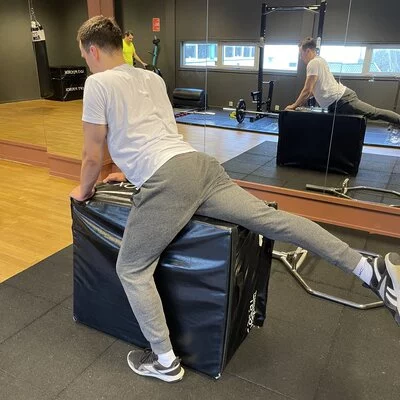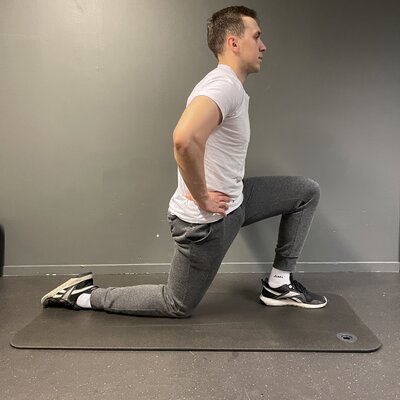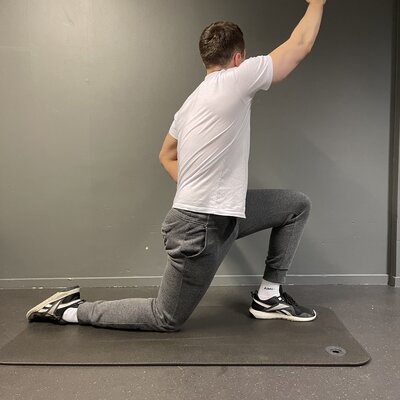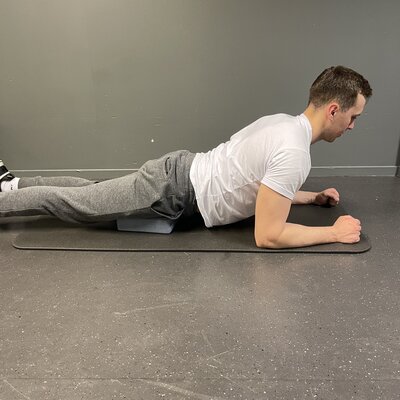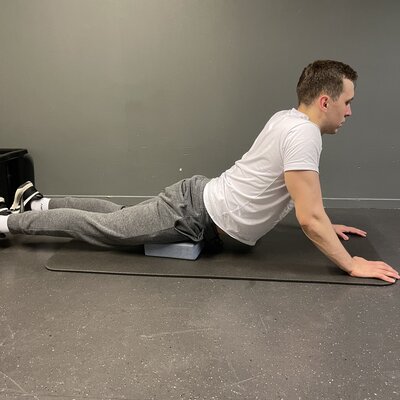Iliopsoas Stretch: 6 Best Stretches For Hip Flexibility and Iliopsoas Tendonitis
In this article I will show you how to achieve the iliopsoas stretch from various starting positions, as well as the theoretical part about iliopsoas function, the connection between hips and lower back, benefits of stretching, stretching for iliopsoas tendonitis and much more.
Let’s dive in.
*You can learn even more iliopsoas stretches in my stretching book.
Iliopsoas Stretch: 6 Best Stretches For Hip Flexibility and Iliopsoas Tendonitis
Standing Iliopsoas Stretch – Basic
Assuming the following position, support one leg and the upper body on a Plyo box or a similar object. Then, lift the upper body using the forearms until you feel a comfortable stretch in the front of your hip.
Hold this position for 30 seconds and repeat with the other leg.
This is one of the best iliopsoas stretch exercises.
Standing Iliopsoas Stretch – Advanced
The starting position is the same as for the Basic iliopsoas stretch, with the difference that when you push the upper body off the Plyo box, you use your hands as a base.
This will result in a stronger stretch of the iliopsoas muscle. Hold this position for 30 seconds and repeat with both legs.
This advanced variation of the iliopsoas stretch can be beneficial for individuals who want to increase the intensity of their stretching routine.
Kneeling Iliopsoas Stretch – Basic
Assuming the starting position kneeling on one leg, place your hands on your hips and rotate your pelvis backward (posterior pelvic tilt).
From this position, lean your upper body forward until you feel a slight tension in the front of your hip.
Hold this position for 30 seconds and repeat with the other leg.
Kneeling Iliopsoas Stretch – Advanced
This exercise is performed in the same starting position as the Basic Kneeling Iliopsoas Stretch variation mentioned earlier.
Rotate the pelvis backwards and lean the upper body forward, while lifting one arm upwards and reaching towards the opposite side of the leg being stretched.
Hold this position for 30 seconds and repeat with the other leg.
Prone Iliopsoas Stretch – Basic
The starting position for this exercise is lying on your stomach with a yoga block placed under the upper part of your thigh bone.
The upper part of the body is left on the floor and is lifted gently using the forearms.
Hold this position for 30 seconds and repeat on the other side.
Prone Iliopsoas Stretch – Advanced
The starting position remains the same as in the aforementioned basic prone iliopsoas stretch variation.
The only difference is that now the upper body is supported with the hands, which will intensify the stretch of the iliopsoas muscle.
Hold for 30s and repeat on other side.
Stretching for Iliopsoas Tendonitis
Iliopsoas tendonitis is characterized by inflammation of the tendon associated with the muscle, which results in pain during the activation of this muscle. The pain is most pronounced when this muscle is working against resistance, such as when climbing stairs or performing strength exercises like squats or lunges.
Stretching the iliopsoas muscle is one of the recommended treatments for iliopsoas tendonitis.
Before starting this stretching exercise, it is essential to consider the following:
- Stretching should not cause pain.
- It is recommended to hold each stretch for 30 seconds in one set.
- The choice of stretching exercises is crucial, and you should focus first on the easiest and simplest stretching exercises before moving on to more challenging iliopsoas stretches.
The easiest exercise for stretching the iliopsoas muscle is from a prone position.
In this position, you can place a yoga block under your thigh bone and gently lift the upper part of your body onto your forearms.
A more advanced variation is to lift the upper body using only your hands.
Another option is to perform the iliopsoas stretch in a standing position, which gives you more control over the stretch and allows you to apply greater tension to the muscle.
Finally, the most challenging variation is to perform the iliopsoas stretch on one knee, which should be done at the end of the stretching routine.
Function of Iliopsoas
The iliopsoas muscle is responsible for lifting the hip joint, a movement known as hip flexion, which means that it is active every time you lift your leg, such as when you walk or climb stairs.
This muscle is unique because it is the only one that connects your lower back (lumbar spine) to your thigh bone (femur).
Its function is essential for maintaining a healthy lower back.
The iliopsoas muscles also play a significant role in keeping your pelvis in the correct position. If these muscles are tight or weak, it can cause an anterior pelvic tilt, which means that your pelvis tilts forward.
This can lead to increased curvature in your lower back, called lumbar lordosis.
Why You Should Stretch Iliopsoas
The number one reason why you should work on stretching your iliopsoas muscle is that we spend a lot of time sitting, around 7 to 8 hours every day on average.
This lack of activity can cause your hips to stay in a flexed position for an extended period, leading to a shortened and inactive iliopsoas muscle.
Wearing shoes or high heels elevates your heels and contributes to shortening your iliopsoas muscle.
When you wear shoes with a high heel, your heels are raised, which causes an anterior pelvic tilt, and this position automatically contributes to the shortening of the iliopsoas muscle.
Benefits of Stretching Iliopsoas
By stretching the Iliopsoas muscle, you will enhance the flexibility of the hip joint and improve the posture of your body.
This improvement in flexibility and posture will contribute to the proper alignment of your pelvis while sitting or standing.
As a result, your lumbar spine will be relieved of excess pressure, and your hip joint will experience less strain during activities such as walking or running.
Tips and Safety Measures when Stretching Iliopsoas
To achieve the best results when stretching your iliopsoas muscle, it is essential you know the following:
The best way to stretch your iliopsoas muscle and the surrounding fascia is when your body is fully relaxed.
You can achieve relaxation through deep breathing, taking a deep breath in for four seconds and exhaling for eight seconds.
This type of breathing stimulates your parasympathetic nervous system, which signals your body to relax and allows the muscle to stretch further.
In simple terms, to stretch your iliopsoas muscle effectively, you need to be relaxed, and deep breathing can help you achieve this state.
When you breathe deeply, your body relaxes, and this relaxation allows the muscle to stretch further.
Don’t bounce into stretching.
If you feel pain or numbness in your legs, stop stretching immediately.
When Stretching Doesn’t Help
If stretching exercises alone do not help you relax your iliopsoas muscle and improve mobility, I suggest you add strengthening exercises for the iliopsoas muscle into your routine.
Specifically, exercises that involve lifting your knee above hip level (hip flexion over 90 degrees).
The reason for strengthening this muscle is that although the iliopsoas may appear to be shortened, it is actually weak.
Therefore, stretching alone may not produce the desired results. By incorporating strengthening exercises, you can improve the strength of your iliopsoas muscle, which can ultimately lead to better mobility and function.
I can help you create a personalized online stretching routine with exercises that are more suitable to you than general stretching exercises on the internet.

